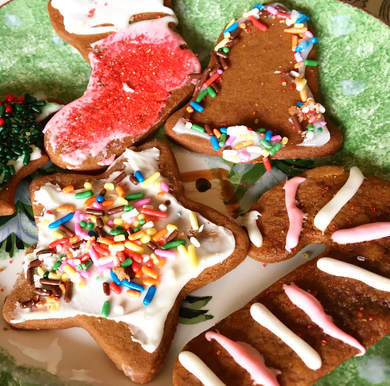Chocolate Macaroons
Friday, September 01, 2017 | By: Becky Diamond
Bite into a macaroon and you are greeted with a delightful contrast of textures - crunchy on the outside and chewy on the inside. This popular confection has had several iterations throughout its history. When first introduced, macaroons were made using very finely chopped almonds mixed with sugar and egg whites, almost like a marzipan. Later versions added coffee, vanilla, chocolate, cinnamon, lemon, orange, nuts or fruit. Today, macaroons are often made using fresh or dried coconut in place of the almonds. They are also sometimes formed into petite pastel colored sandwich cookies with a ganache filling.
There are conflicting stories about the origin of macaroons. Some authorities claim they are a product of Italy, particularly Renaissance-era Venice, with the name stemming from the Italian word maccherone and the Venetian macarone (which means fine paste). Indeed, Italian amaretti use the same ingredients with slightly varied amounts. However, the French also claim ownership. One story asserts the recipe originated in the town Cormery, where macaroons have been made in the monastery there since 791. Amusingly, the design of the cookie was said to mimic the shape of the monks’ navels. The city of Nancy also maintains they are the inventor of macaroons. Their version achieved fame by the 17th century, and became known as “Macaroons of the Macaroon Sisters.”
In America, recipes have been just as diverse, many using ingredients that were readily available, such as oatmeal, hazelnut, strawberry and apple jelly. The famous Delmonico’s Chef Charles Ranhofer featured seventeen different variations in his opus, The Epicurean.
The version I chose to try was Chocolate Macaroons, from another famous French chef, Pierre Blot. Best known as America’s first celebrity chef, Blot took his popular cooking classes “on the road” in the late 19th century. Instead of using crushed almonds to make these macaroons, Blot makes a paste out of baking chocolate, sugar and egg whites. Just these three ingredients made a deliciously chewy cookie that was also quick and easy to assemble.
The original recipe was featured in a little cookbook published in 1886 by Baker’s Chocolate company called Cocoa and Chocolate: A Short History of Their Production and Use. (At that time, companies were starting to promote their products via recipes and cookbooks). The recipe is as follows:
Chocolate Macaroons. Melt on a slow fire and in a tin pan three ounces of chocolate without sugar (known as Baker's chocolate); then work it to a thick paste with one pound of pulverized sugar and three whites of eggs. Roll the mixture down to the thickness of about one quarter of an inch; cut it in small round pieces with a paste-cutter, either plain or scalloped; butter a pan slightly and dust it with flour and sugar, half of each; place the pieces of paste or mixture in and bake in a hot, but not quick oven. Serve cold. — Pierre Blot
My revised version is very similar; I just increased the chocolate to 4 ounces to boost the chocolate flavor:
Chocolate Macaroons
- 4 oz. baking chocolate (typically 1 pkg)
- 3 egg whites
- 3 1/2 cups powdered sugar
- Preheat oven to 375°F. Line two large baking sheets with parchment paper.
- Melt chocolate in a glass bowl in the microwave in 30-second increments, stirring well in between. Or melt over a pot of simmering water on the stove. Allow to cool.
- Mix the egg whites with the chocolate and then sift the powdered sugar into the mixture in increments until it forms a stiff dough.
- Using a cookie scoop or teaspoon, scoop balls of dough on cookie sheets, leaving about an inch in between.
- Bake 10-12 minutes until puffed and then cool on baking sheets before transferring to a wire rack. Cookies will deflate and become flat once they cool.
Makes about 2 1/2 dozen.
Sources: Good Cooking by Marjorie Heseltine and Ula M. Dow; Dictonary of Gastronomy by Andre l. Simon and Robin Howe; Larousse Gastronomique; The Oxford Companion to Food by Alan Davidson.






0 Comments